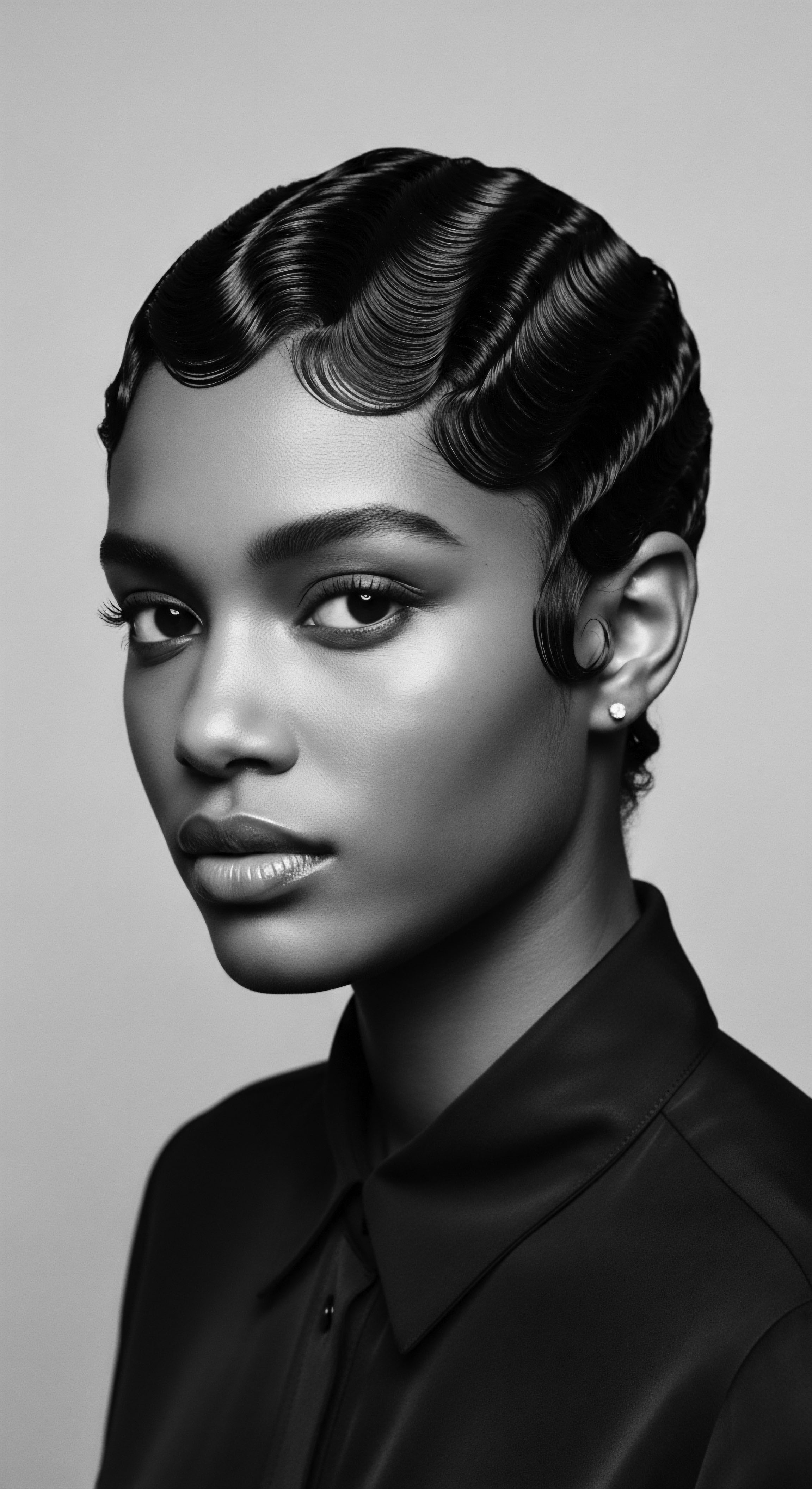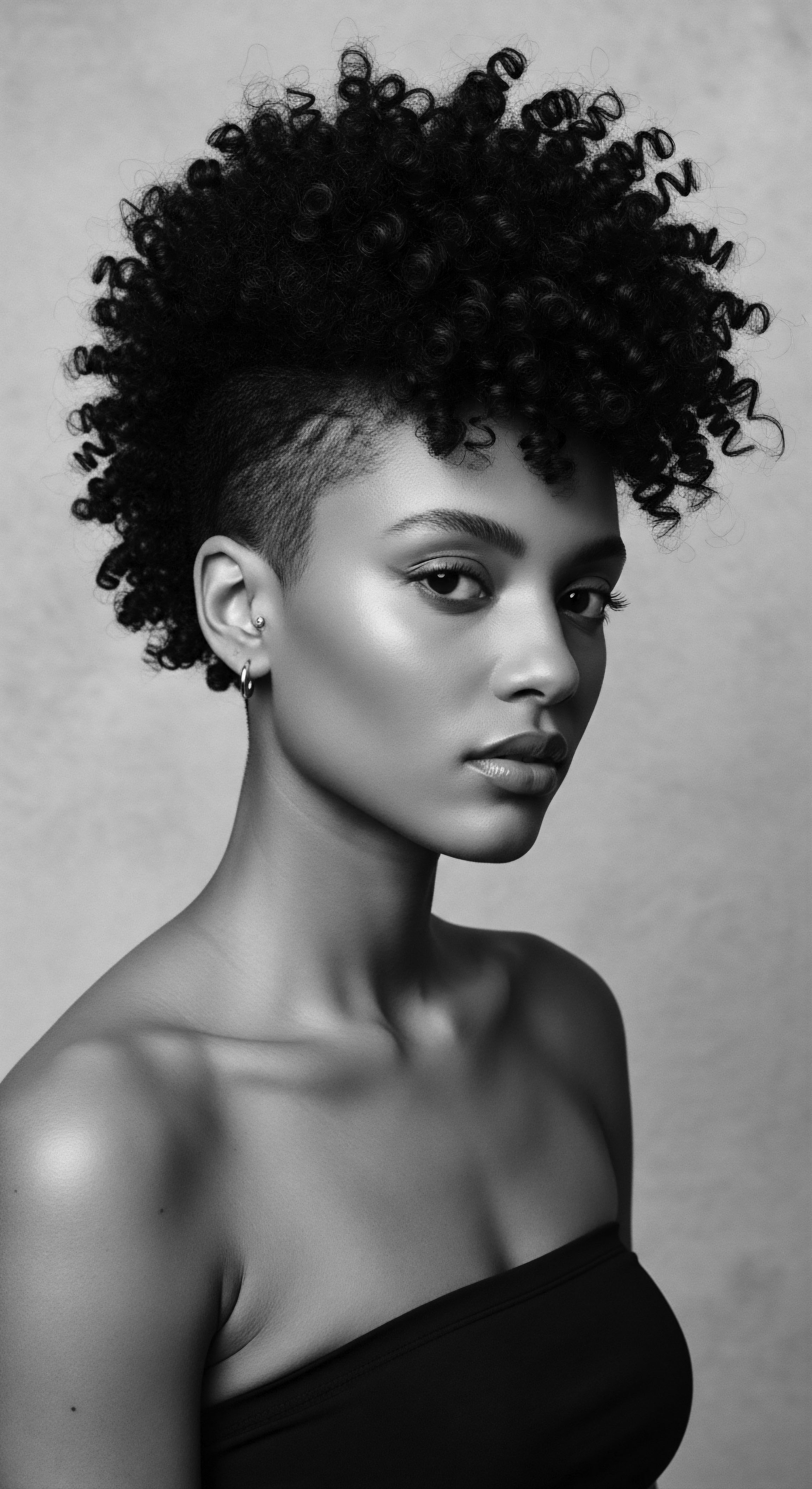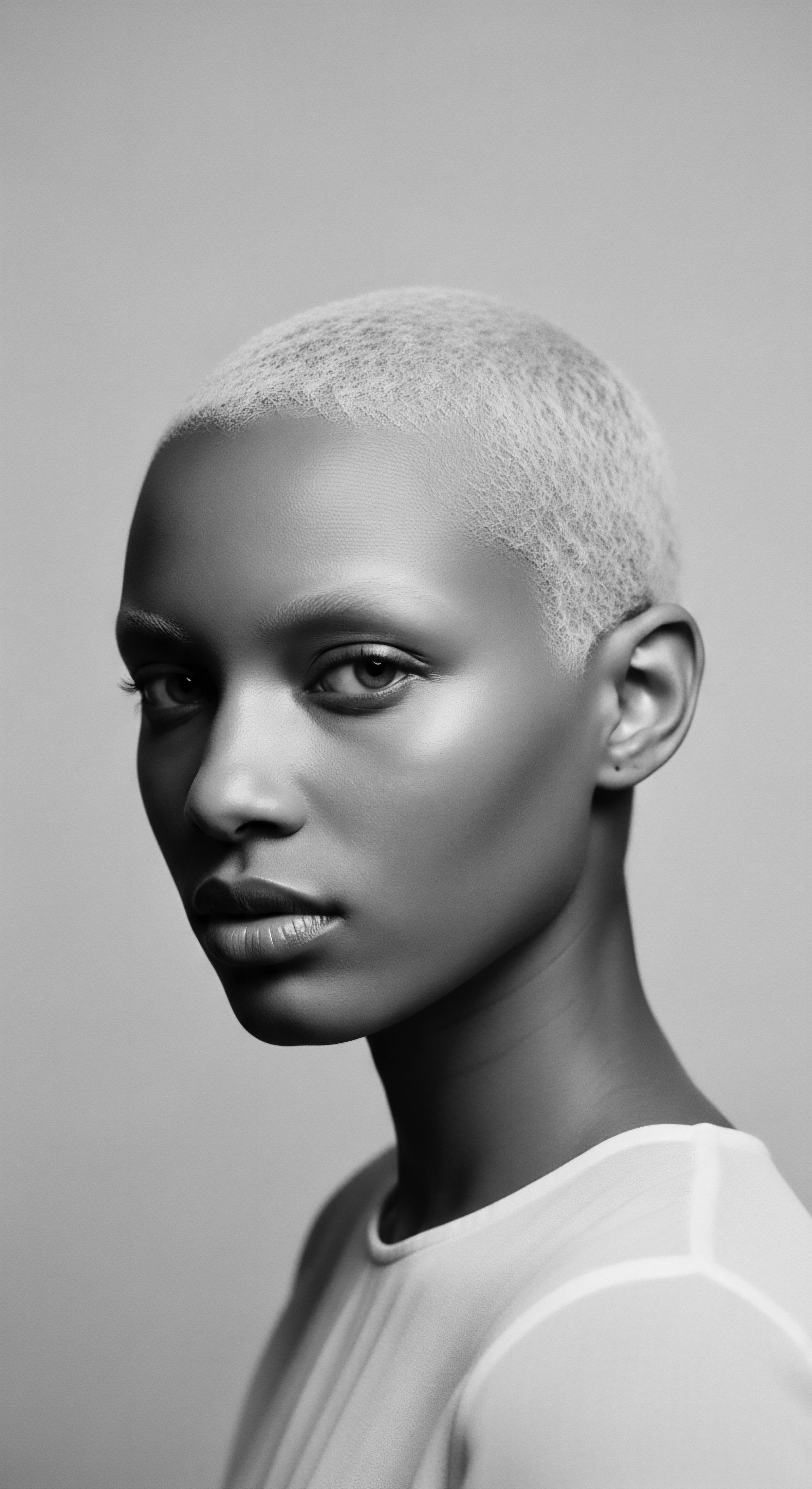The journey into the understanding of Rhassoul Clay Practices begins with a deep reverence for Earth’s ancient generosity and the ancestral wisdom that recognized its intrinsic value. This is not merely a modern beauty trend; rather, it is a profound echo from the past, a living tradition intertwined with the very fabric of textured hair heritage. Roothea’s voice seeks to unravel the intricate layers of this clay’s existence, from its elemental genesis to its sacred place in rituals of care, community, and identity across generations and geographies. The delineation of Rhassoul Clay Practices transcends a simple definition; it encompasses a spiritual and scientific inquiry into a natural gift that has nurtured hair and spirit for millennia.

Fundamentals
The Rhassoul Clay Practices stand as a testament to the enduring human connection with natural elements for wellness and beauty. At its core, the Rhassoul Clay Practices refer to the comprehensive application and integration of Rhassoul clay—a unique mineral substance primarily sourced from the Atlas Mountains of Morocco—into regimens of self-care, particularly those centered around hair and skin. This indigenous clay, also known as Ghassoul, holds a name derived from the Arabic verb “rassala,” meaning “to wash”. Its fundamental purpose revolves around cleansing, purification, and conditioning, yet its significance extends far beyond mere cosmetic function.
This earthen treasure has been recognized for its ability to absorb impurities and excess oils without stripping away natural moisture, a delicate balance especially cherished by those with Textured Hair. Unlike many conventional cleansers that can leave hair parched or brittle, Rhassoul clay works by a process of adsorption, where negatively charged clay molecules attract and bind with positively charged impurities and toxins, allowing them to be gently rinsed away. This action promotes a clean scalp and supple hair strands, fostering an environment where natural curl patterns can flourish unhindered.
The elemental composition of Rhassoul clay sets it apart, consisting primarily of magnesium silicate, alongside other beneficial minerals such as silica, potassium, calcium, and iron. These mineral constituents contribute to its unique properties, offering gentle exfoliation, softening capabilities, and even a natural revitalizing effect for both skin and hair. The traditional method of its preparation, often involving meticulous washing, sun-drying, and pulverization, ensures that these inherent qualities remain preserved, ready to impart their benefits through ancient rituals and contemporary applications.
The description of Rhassoul Clay Practices, from a foundational standpoint, encompasses not only the clay itself but also the historical and methodological traditions surrounding its utilization. These practices emphasize a return to simplicity and reverence for natural resources, a principle that deeply resonates within the heritage of Black and mixed-race hair care. It speaks to a shared ancestral knowledge of the Earth’s restorative capacities.
Rhassoul Clay Practices fundamentally signify the ancestral and modern application of a unique Moroccan mineral clay for hair and skin purification, emphasizing its gentle, mineral-rich cleansing properties.
Beyond its mineral makeup, the practices linked to Rhassoul clay are rooted in a philosophy of holistic well-being. For centuries, communities in North Africa have treated this clay not just as a product but as a sacred component of their cleansing rituals. This reverence is apparent in its inclusion as a traditional wedding gift for brides in Morocco, underscoring its cultural value and its deep connection to personal care and well-being within those communities. The simplicity of mixing the powdered clay with water to create a paste for hair or skin application speaks to an intuitive understanding of natural chemistry and a profound trust in earthen remedies.
- Origins in the Atlas Mountains ❉ Rhassoul clay is exclusively mined from ancient sedimentary deposits within the Atlas Mountains of Morocco, making it a truly regional treasure. This specific geological origin, a lacustrine sedimentary formation from the Tertiary age, means it is a unique volcanic rock, altered over time.
- Etymological Significance ❉ Its name, Rhassoul (or Ghassoul), carries the meaning “to wash” in Arabic, a direct testament to its primary historical and practical purpose as a natural cleansing agent. This linguistic root immediately establishes its foundational role in traditional hygiene and beautification.
- Mineral Richness ❉ The clay is distinguished by its high concentration of beneficial minerals, particularly Silica (around 52%) and Magnesium (around 25%), alongside calcium, potassium, and iron. These elements contribute to its unique texture and its gentle yet effective cleansing properties without dehydrating hair or skin.

Intermediate
The intermediate meaning of Rhassoul Clay Practices delves beyond its basic functions, recognizing it as a sophisticated ancestral system of care that harmonizes elemental biology with living tradition. This expanded perspective acknowledges the clay not merely as a cleansing agent, but as a conditioner, a detangler, and a scalp treatment, particularly valuable for the delicate and diverse needs of Textured Hair. Its intrinsic properties allow for a remarkably gentle cleansing action that respects the natural lipid barrier of the hair and scalp, a consideration often overlooked by modern, harsher cleansers.
The application of Rhassoul clay, often prepared as a smooth, creamy paste by mixing with water or floral waters like rose or orange blossom, speaks to an artisanal approach to hair care. This preparation method itself is a practice passed down through generations, often incorporating herbs and spices in a “water-based marinade” during its processing, which enhances its efficacy and aromatic appeal. The resulting preparation is then applied to damp hair, massaging the scalp and distributing the mixture through the strands, a ritualistic act of nourishment and purification.
The significance of Rhassoul Clay Practices for textured hair lies in its unique capacity to cleanse without stripping, a profound distinction for curls, coils, and waves that naturally tend towards dryness. Conventional shampoos, with their harsh sulfates, can disrupt the delicate balance of the scalp’s hydrolipidic film, leading to dryness, frizz, and breakage. Rhassoul clay, conversely, works through ion exchange and adsorption, drawing out impurities and excess sebum while allowing the natural oils that protect and moisturize the hair to remain intact. This gentleness helps to preserve the hair’s inherent moisture, reducing the likelihood of tangles and improving overall manageability.
Rhassoul Clay Practices offer a refined, ancestral cleansing method for textured hair, preserving natural oils and promoting curl definition through its unique mineral composition and gentle adsorptive action.
This dedication to preserving the hair’s natural state resonates deeply with the heritage of Black and mixed-race hair care, where hair has long been understood as a living extension of identity and ancestral connection. The practice of using earthen materials like clay represents a profound wisdom, recognizing that the Earth herself holds the keys to well-being.
Moreover, the intermediate understanding of these practices incorporates the sensory experience. The earthy scent, the smooth texture, and the calming sensation of the clay upon the scalp evoke a connection to tradition and a mindful moment of self-care. It transforms a routine washing into a ritual, a tender act of honoring one’s hair and its lineage. The traditional hammam experience, a cornerstone of Moroccan and North African culture, exemplifies this, where Rhassoul clay is a central element in a multi-step cleansing and relaxation ritual, creating a holistic approach to beauty and spirit.
| Hammam Stage Steam & Warmth |
| Purpose Opens pores, softens skin and hair for deeper cleansing. |
| Rhassoul Clay Connection & Heritage Insight Prepares the body and hair to receive the clay's benefits, mirroring ancestral understanding of natural heat. |
| Hammam Stage Black Soap Application & Exfoliation |
| Purpose Deep cleansing, removal of dead skin cells with a Kessa glove. |
| Rhassoul Clay Connection & Heritage Insight Sets the stage for clay's purifying action, emphasizing communal and multi-layered cleansing rituals passed down. |
| Hammam Stage Rhassoul Clay Application |
| Purpose Purifies, detangles, and conditions hair and skin; absorbs impurities. |
| Rhassoul Clay Connection & Heritage Insight The central act, where the clay's unique cleansing and softening properties for hair are fully utilized, linking directly to its ancestral recognition as a wash and conditioner. |
| Hammam Stage Rinsing & Nourishment |
| Purpose Removes clay, followed by application of Argan oil or rose water. |
| Rhassoul Clay Connection & Heritage Insight Completes the ritual, sealing in moisture and reflecting the reverence for natural oils and essences in heritage care. |
| Hammam Stage These stages collectively represent a continuum of ancestral wisdom, with Rhassoul clay serving as a timeless anchor for holistic cleansing and well-being. |
The intermediate perception of Rhassoul Clay Practices therefore transcends mere product use, embodying a legacy of natural care that acknowledges the unique characteristics of textured hair and celebrates a deeper, more mindful connection to personal grooming as a heritage act.
- Saponiferous Qualities ❉ While not a soap in the conventional sense, Rhassoul clay possesses natural saponiferous properties, meaning it has a gentle foaming action when mixed with water. This quality allows it to cleanse effectively without the harsh surfactants often found in commercial shampoos, which can strip precious oils from textured hair.
- Enhanced Curl Definition ❉ For individuals with curly or coily hair patterns, the practices contribute to improved curl definition and reduced frizz. By cleansing without over-drying and by absorbing excess sebum without disrupting the hair’s natural structure, the clay helps coils clump together more effectively, revealing their intrinsic shape.
- Scalp Health Regulator ❉ Beyond cleansing the hair strands, Rhassoul Clay Practices are particularly beneficial for scalp health. The clay aids in regulating sebum production and gently removing dead skin cells and buildup, offering relief for itchy scalps or conditions like dandruff, without causing irritation. This fosters a balanced environment essential for healthy hair growth, a cornerstone of ancestral hair care philosophies.

Academic
The academic elucidation of Rhassoul Clay Practices necessitates a rigorous interdisciplinary approach, drawing from mineralogy, ethno-cosmetology, historical anthropology, and the nuanced understanding of diasporic hair narratives. Here, Rhassoul Clay Practices are interpreted as a complex system of ancient bio-mineral technology, culturally embedded and perpetuated, which has historically provided exceptional epidermal and pilary care, particularly pertinent to the architectural nuances of Textured Hair. Its precise scientific definition is a magnesium-rich smectite clay, specifically a stevenstite, characterized by its layered crystalline structure and high cation exchange capacity. This inherent molecular arrangement grants the clay its extraordinary adsorptive and absorptive capabilities, allowing it to bind with positively charged impurities, oils, and environmental pollutants on the hair shaft and scalp without causing the desiccation often associated with conventional anionic surfactants.
The true significance of Rhassoul Clay Practices transcends a mere chemical reaction; it embodies a profound cultural legacy. Archaeological evidence suggests the use of various clays for cosmetic purposes dates back to ancient Egypt around 4000 BCE, with Rhassoul clay specifically noted for its regenerative and healing properties in Egyptian papyri. Its historical use in North Africa extends for millennia, deeply integrated into the communal and personal rituals of cleansing and purification, most notably within the traditional hammam experience. The preservation of these practices, passed through matrilineal lines in Moroccan communities, reflects an unbroken chain of ancestral knowledge regarding natural resources for well-being.
Rhassoul Clay Practices represent a sophisticated ancestral bio-mineral technology, scientifically validated for its gentle purification and conditioning, intrinsically linked to the cultural continuity of textured hair care traditions.

The Geochemical Underpinnings and Hair Biomechanics
The efficacy of Rhassoul clay for textured hair lies in its distinct geochemical composition. Comprising approximately 52% silica and 25% magnesium, along with appreciable levels of calcium, potassium, and iron, this mineral profile directly influences its interaction with the hair cuticle and scalp epidermis. Silica is known to support hair vitality by delivering minerals to the hair follicle and strengthening blood vessels, while magnesium contributes to strengthening hair follicles and the overall hair structure.
From a biomechanical perspective, textured hair, characterized by its elliptical cross-section and varying degrees of curl density, often possesses a lifted cuticle layer, which can make it prone to moisture loss and tangling. Traditional cleansers that generate excessive lather and strip natural oils exacerbate these tendencies. Rhassoul clay, by contrast, operates with a low-lathering, non-stripping action, minimizing cuticle disturbance and preserving the hair’s natural hydrolipidic film.
This gentle cleansing mechanism helps maintain the integrity of the hair strand, reducing friction between individual coils and facilitating detangling, a crucial aspect of caring for tightly coiled or curly hair patterns. Its unique ability to absorb excess sebum without dehydrating the hair shaft makes it an exceptional choice for maintaining scalp health, an essential foundation for healthy hair growth across diverse hair textures.

Cultural Continuity and Diasporic Resonances
The Rhassoul Clay Practices extend beyond Morocco’s borders, finding resonance within the broader cultural currents of the African diaspora. While direct historical evidence of Rhassoul clay being extensively traded into Sub-Saharan Africa and subsequently reaching the Americas during early periods is less explicit than for commodities like gold or salt, the concept of earthen washes and natural cleansing agents held deep roots across various African societies. Many traditional African hair care systems relied on natural, locally sourced ingredients—such as various indigenous clays, plant extracts, and butters—for cleansing, conditioning, and scalp health, reflecting a parallel ancestral wisdom in harnessing the Earth’s provisions.
One compelling historical example that powerfully illuminates the Rhassoul Clay Practices’ connection to textured hair heritage and ancestral practices lies in the enduring wisdom of Amazigh Communities in North Africa. The Amazigh people, indigenous to regions where Rhassoul clay is exclusively sourced, have maintained continuous, intergenerational practices surrounding this earth mineral. Their traditional use of Rhassoul clay is not merely transactional; it is deeply embedded within a holistic cultural cosmology, where connection to the land and its resources forms a bedrock of identity and spiritual well-being. As an example, the meticulous traditional preparation of Ghassoul stones into a usable paste, often involving a prolonged maceration with specific herbs and plant essences like orange blossom or myrtle, is a closely guarded ritual passed from mother to daughter.
This deeply personal transmission of knowledge contrasts sharply with industrialized production, emphasizing the clay’s sacred dimension and its role in communal beauty rituals, such as those within the hammam, which historically served as vital social hubs, particularly for women. This continuity, spanning millennia, showcases a rigorous, indigenous understanding of the clay’s properties that predates modern scientific validation. For instance, the traditional inclusion of Rhassoul clay as a significant component of a Moroccan bride’s dowry underscores its profound cultural value, symbolizing purity, beauty, and wellness for the transitioning woman. This act of gifting highlights the clay’s intrinsic link to significant life passages and its role in upholding communal standards of care and presentation.
The profound continuity of this localized, deeply spiritual practice serves as a powerful testament to the longevity of ancestral practices using earthen materials for hair and body care, a heritage that resonates with the broader global movement towards natural ingredients for textured hair within the diaspora, signifying a reclamation of ancestral wisdom (Hakim, 2019). The yearning for and subsequent re-adoption of natural ingredients like Rhassoul clay by diasporic communities, even if the direct physical transfer was historically limited, represents a spiritual and cultural reconnection to ancestral ways of life that privileged the Earth’s offerings for holistic wellness.

Beyond Cleansing ❉ Therapeutic and Societal Implications
The academic discourse surrounding Rhassoul Clay Practices extends into its therapeutic applications and broader societal implications. Beyond its cosmetic properties, the clay exhibits anti-inflammatory and antiseptic qualities, making it beneficial for various scalp conditions. Its capacity to soothe irritated skin and reduce redness aligns with traditional uses for dermatological issues. This therapeutic dimension elevates its status from a simple cosmetic ingredient to a medicinal medium, as noted in various historical accounts.
From a contemporary perspective, the re-emergence of Rhassoul Clay Practices within Western natural hair movements represents a significant cultural phenomenon. This resurgence signifies a conscious turning away from chemically laden products towards ancestral solutions, a movement deeply rooted in the historical experiences of Black and mixed-race individuals reclaiming agency over their hair and identity. The choice to incorporate Rhassoul clay into modern hair care routines often symbolizes a defiance of oppressive beauty standards and an affirmation of natural beauty, echoing the resilience and self-determination ingrained in the heritage of textured hair care. It embodies a search for authenticity and a connection to roots that colonialism sought to sever.
The practice offers not only physical benefits but also psychological solace, linking individuals to a shared lineage of self-care and communal wisdom. This connection to ancestral methods transforms a simple wash day into an act of remembrance and cultural preservation. The academic examination of Rhassoul Clay Practices thus becomes a lens through which to explore the enduring power of heritage, the interconnectedness of human well-being with the natural world, and the ongoing dialogue between ancient wisdom and contemporary scientific understanding.
- Mineral Adsorption Mechanism ❉ Rhassoul clay’s efficacy stems from its negatively charged molecular structure, allowing it to adsorb (attract and bind to its surface) positively charged impurities, toxins, and excess sebum from the scalp and hair. This process purifies without stripping the hair’s vital natural oils, a key benefit for retaining moisture in textured strands.
- Scalp Microbiome Support ❉ By gently regulating sebum and removing buildup, Rhassoul Clay Practices contribute to a healthier scalp microbiome. A balanced scalp environment is crucial for optimal hair growth and minimizing conditions common in textured hair, such as dryness, flakiness, or irritation.
- Hydrophilicity and Swelling Index ❉ The clay minerals within Rhassoul exhibit a strong affinity for water, causing them to swell significantly when hydrated. This swelling creates a gel-like consistency that makes the clay easy to distribute through dense, curly, or coily hair, providing slip for detangling and ensuring even application of its beneficial minerals.
- Historical Transmission of Knowledge ❉ The method of preparing Rhassoul clay, including the specific herbs and processing techniques, has been guarded and passed down through generations within Amazigh communities. This oral and experiential transmission represents a sophisticated, empirically derived understanding of material science, predating formal laboratories.

Reflection on the Heritage of Rhassoul Clay Practices
As we complete this journey into the understanding of Rhassoul Clay Practices, a profound realization settles upon the spirit ❉ this elemental gift from the Atlas Mountains is far more than a simple cosmetic ingredient. It represents a deep, unwavering thread connecting generations, continents, and traditions. The practices surrounding Rhassoul clay are living archives, whispering stories of resilience, ingenuity, and profound respect for the Earth’s provisions, particularly for those whose hair carries the echoes of ancient lineages.
From the meticulous hands that traditionally processed the raw clay in Moroccan hearths to the modern hands that now seek its gentle touch for textured hair across the globe, a continuous narrative unfolds. It speaks to a collective longing for authenticity, a return to the wisdom embedded in ancestral ways, and a recognition that true beauty often resides in the simplicity and purity of nature. Rhassoul Clay Practices affirm the inherent right to honor one’s hair in ways that celebrate its natural architecture, its unique history, and its connection to a rich cultural heritage.
The enduring significance of these practices for Black and mixed-race hair experiences cannot be overstated. In a world that historically sought to homogenize and often denigrate textured hair, the reclamation of ancestral practices like those involving Rhassoul clay becomes an act of self-love, a declaration of identity, and a profound acknowledgment of the strength and beauty passed down through every strand. It is a testament to the enduring “Soul of a Strand,” a living testament to memory, tradition, and the unending journey of self-discovery through connection to our deepest roots.

References
- Hakim, Z. (2019). The Berber Women of the Atlas ❉ Traditions and Adornments. Al-Andalus Publishing.
- Illes, J. (2015). Earth Medicine ❉ The Ancient Art of Clay Healing. Llewellyn Publications.
- Matike, M. S. Ekosse, G.-E. & Ngole, V. M. (2010). Cosmetic Uses of Clay Minerals ❉ A Review of Historical and Present-Day Applications in Africa. Journal of Minerals & Materials Characterization & Engineering, 9(2), 137-147.
- Murray, H. H. (2007). Applied Clay Mineralogy ❉ Occurrences, Processing, and Applications. Elsevier.
- Ould El Hadj, L. & Cherif, A. (2018). Traditional Moroccan Cosmetics ❉ Medicinal Plants and Earth-Based Products. Journal of Ethnopharmacology, 219, 134-142.
- Robertson, R. H. S. (1986). The Clay Minerals Society ❉ Its First Twenty-Five Years, 1963-1988. The Clay Minerals Society.
- Williams, L. B. & Haydel, S. E. (2010). Evaluation of the Medicinal Use of Clay Minerals as Antimicrobial Agents. Environmental Geochemistry and Health, 32(5), 745-758.
